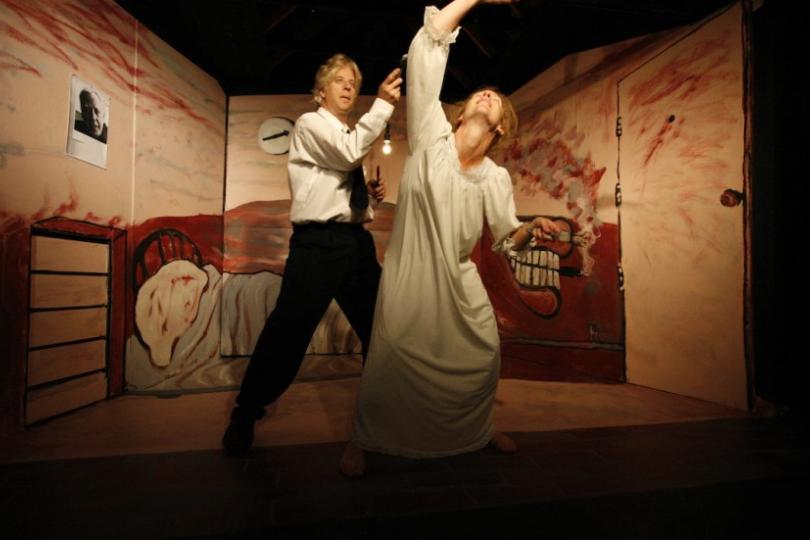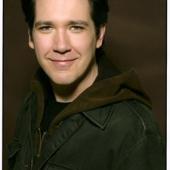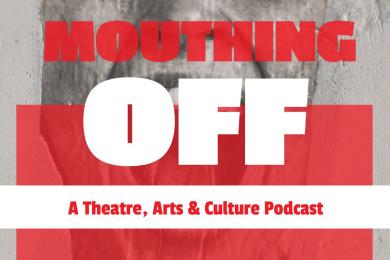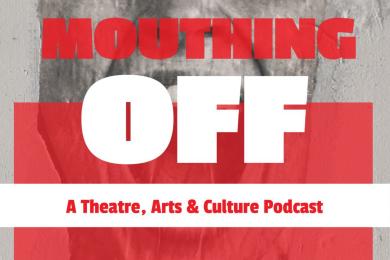Playlist profile: Paul Herwig and Jennifer Ilse
Interview

Paul Herwig and Jennifer Ilse founded Off Leash Area (OLA) in 1999 and in that time have created more than 23 full-length works. But they wouldn’t be surprised if you didn’t know that. The couple, who are not only professional collaborators but are also married, sat down with me in their South Minneapolis home to talk about their company, their work and to clear a few things up.
Paul had posted in the comments section following my interview with Michelle Hensley last month and said some provocative things. It piqued my interest. I wanted to ask him some questions about what he said, so I ended up getting in touch. Because I was familiar with OLA’s reputation but not their work (again, they’re not surprised), I was excited to talk to them as a complete beginner. Thankfully, they had also recently been the subject of a segment on tpt’s MN Original, so I checked it out and got a quick crash course.
Here, I dig a little deeper.
How would you describe your work to a neophyte?
Jennifer Ilse: That’s always such a hard question! You take a shot at it.
Paul Herwig: That question gets answered according to what the context is, but we’re an interdisciplinary performance company. We don’t call ourselves a theater company, because we’re really mixed with dance and we’re not script-based. We sit on the fence between theater and dance. The director of most of our shows is Jennifer who’s a dancer, so she directs like a choreographer. It’s subtly different from a director of theater. I have a visual art background, so a lot of our shows are heavy on production and sets, but the sets aren’t there to describe place and time. They’re very interactive with the performers, they change, there’s live painting.
I think we’re also kind of a misfit company, in that we just don’t fit in. And it’s not that we’re, capital letters, SO UNIQUE. I think we are unique, but we’re a misfit company because we don’t work like a theater company, we don’t hire people like a theater company does. We work more like a dance company in that we take a long time to work on our shows. We only do original work. And our purpose is that we only do signature work, only Jennifer and Paul work.
Yeah so we’re a kind of do-it-yourself, misfit, contemporary-but-friendly theater and dance company.
What is a typical process for one of your shows? Or is there one?
JI: We actually do have a pretty specific process. We’ve figured out a way to work that works well for us. Basically, we have a first chunk of time where we just sit and brainstorm ideas, everything is on the able, we write everything down. Then we assimilate those ideas into a structure. We look for what that innate structure is, and that can be something that is more narrative or less, depending on the show and what it seems to be calling for. Then once we have a really solid structure we go to the rehearsal space. So once we get there, we know what basically is going to happen and what we want to say. I like to call them a series of events.
We often start with a more workshop-type part in the beginning of rehearsal to flush out physicality and what the characters can be like. If there is text that’s when we start playing with it in lots of different ways. Sometimes the action needs to drive a scene and sometimes the text does. So we work accordingly, and whether the writer we’re working with needs to go work on things first for a particular segment, or whether we need to generate stuff first before that writer can really continue. Then we layer it that way, and we keep layering in the rehearsal process. We flush out a lot of raw material, see what it looks like and then put on the next layers until we get to the point where we’re doing a really solid run. Then we get a lot of feedback from people to poke holes in it, and try to help us hone it.
PH: A big part of why we work the way we do, which looks different from the way most people do theater, is because we’re using what we’ve got. I didn’t go to college and I didn’t get training in script-based theater. And because I’ve come from a visual art interest – ever since I was a kid, even though I’m half blind – that’s a big part of why, in the performance world, my work looks like that.
Jennifer is really theatrical, and most dancers aren’t. She has a real proclivity for theater, so we meet there. She doesn’t really fit in the dance world, I don’t really fit in the theater world. So our work looks like this because we’ve tried to work together. It’s very organic.
Everybody does the work they do because they don’t like the work other people are doing. You end up making the work you want to see. Our process is very intuitive. I don’t think we’ve ever done a show because we wanted to attack a particular social issue, or because there’s a certain style in the world of performance that we want to be involved in. We’ve always thought about the feeling: a sense of isolation or of not belonging or of loss. It’s a simpler way of starting.
So I would say our shows feel personal but not indulgent–and arty but not impenetrable.
Who are some artists who have inspired you over time?
PH: When I was a kid and I just wanted to be a theater person, Jean Genet was an inspiration. And Beckett, although I don’t think I understood what they were about when I was that old. But it was just so imaginative and so different, a different language. I’ve never been interested in Shakespeare, I find it excruciatingly boring. It’s beautiful poetry to read, but I have zero interest in it, and I know it’s sacrilege to say that, but it simply doesn’t speak to me. And I’ve seen really good Shakespeare, I saw 10,000 Things do a play. And it came alive for me, still, I just wasn’t interested. I like cheesecake, but I wouldn’t buy it if I had a choice. I’d buy something else.
Robert Wilson and Robert LePage were interesting to me when I was in my 20’s, but I think after that it was all dance people and visual art stuff. I thought Pina Bausch was incredible. Sankai Juku, this wonderful butoh company. Both of them are really image heavy. Now, it’s just artists. I grew up wanting to be a painter not a theater person, so it’s a full circle thing that’s happened.
JI: I feel like so often I’ll see a performance of a company, and it blows me away, and I’ll see something else they do, and I’ll be like yeah, that was good. I’ve never had the one [company or artist] that makes me go, That’s the one!
So it’s usually performances that I remember. When Shockheaded Peter [by Improbable Theater] came to town years ago in the old Jeune Lune space, it was really fantastic. There’s a local company BodyCartography that does really contemporary work with body-mind-centering stuff, and they did a show that just blew me away and has stayed with me forever. The show they did at the Walker two years ago, it was called Super Nature.
They [Emio Greco & PC, a Belgian/Italian dance/design collaborative] did a duet at the Southern a number of years ago and the whole audience jumped to their feet, it was just so powerful! Then they came to the Walker later it was just, ehhh.
PH: it was a commission. Any time the Walker commissions a piece it’s not very good.
JI: What is that?!
PH: I think it’s the chocolate ganache theater they have to perform in.
JI: And then Luciana Achugar who came and choreographed at Zenon, yeah, it was really trippy and really powerful. She spent like the first 45 minutes doing this ritual dance thing over and over and over. It was this really super feminist statement, and it was really powerful.
And locally a company I really have a heart for is Joe Chvala and Flying Foot Forum. They feel really similar to us in that Joe and Carla, although they’re not married, are a duo who have been working together for a really long time and have their feet in both dance and theater.
PH: The best Theater theater thing I saw was In the Red and Brown Water at the Guthrie [produced by Pillsbury House Theatre and the Mount Curve Company]. It was incredible. And I think one of the things I like about it is that the script was really stylized, which is something that really interests me in theater. I feel like a lot of theater looks like it could be made by the same company, just different budgets. With that play, I could feel the artist in the writing, and I thought it could be even more so.
But I keep looking around the Twin Cities and wondering, where’s the Richard Foreman of the Midwest? Where’s that person and why aren’t they getting produced? Where are the iconoclasts, the people who are just trying to defiantly be themselves in order to be different?
What are some of the strengths and some of the challenges of having your life partner also be your work partner?
JI: Well, the challenge is that when things are bad, and that doesn’t necessarily mean in the collaboration, but if you get a shit-ass review or you don’t get a grant, whatever, we’re always in it together. Usually in couples, if one person’s career is having major setbacks, the other person can hopefully support them through it. We don’t have that.
The perfect example is one time we took a show to the Edmonton Fringe. It was a show that was super successful here, it was really early on, 2002, we got the best review of our lives, and this was when reviews still helped a ton. So we took it to Edmonton. Our first night we had a packed 200-seat theater, and they were laughing so hard!
PH: They stopped the show they were laughing so hard!
JI: So we left that show thinking, we’re going to be the stars of the fringe! Yeah! Then later we were walking down the street with a couple of other performers we’d become friends with, and they were reading the paper. And all of a sudden they went, “oh!” And we say, “what, did our review come out?” And they were like, “yeah, you can read it later.” So we thought, oh shit, and we read it. It was by a rock critic who didn’t know anything about our kind of work, and he just destroyed it. Destroyed our show! And sure enough then next night, it was just a pathetic audience. I remember at one point, both of us sitting next to each other at the edge of the bed, not moving, just in complete despair. There was just nothing to say.
PH: So we cancelled the fringe, went on a backpacking trip and went home.
I do think one of the things we’ve discovered – and I think I can say this for you, I know I can say it for me – I know that the work that I do is better when she is involved. It isn’t as good, I can’t get to where I want to go, if I do it by myself. And it hasn’t been easy to get to that place. Even though we come from different disciplines, there’s always ego involved. And you have to have some ego, it’s way too fucking hard to do this without some ego.
JI: Yeah! We really do have different strengths, and when we figured out how to make them work together, and it took a while, the sum total is really strong.
I was thinking about some of the comments you made in response to Michelle’s interview –
JI: And by the way I didn’t agree with all of them. I read it and I thought, how did you get that out of what Michelle said?
I was just happy that someone read the interview! And I was thinking about a word you used: fundable. I think I understand how Off Leash Area fits into the artistic landscape, but do you have a sense of how you fit into the funding landscape?
JI: We write a zillion of grants, and we see what’s out there.
PH: And we’re pretty successful at finding the grants that we could get.
JI: There’s not a lot available for people like us. For the size of organization that we are –
PH: That’s the big one!
JI: –the problem with foundation money being the prime support for arts in America is that they want to give to big institutions. The number of places we could even write a grant to is so small, and those few are so very competitive because of that. There are places where 2% of applications are funded. It’s fucking hard!
John Munger who passed a couple of years ago, was our Board Chair for several years, and he would say, “You’re the most recognized and awarded arts company that a bunch of people don’t know about.” Because we can’t get past this funding point. And there is very much a thing where organizations want to fund things that help the community, that foster social change.
We feel really strongly that that can be a really potent part of art, and it’s important. It is important. But it can’t be the only driving thing out there.
PH: It isn’t the potent part of what makes art art.
JI: It’s an important part of the landscape of art, but it seems to be the only thing or the very predominant thing that foundations want to fund.
PH: And it’s not sour grapes. For what we do and the games we choose not to play, we get a lot of funding for Off Leash Area. We get grants every year for our projects. I’ve received a McKnight, we’ve each received two State Arts Board Artist Initiative grants. We have all this stuff that we get, so it’s good. We’re doing well, we’re getting recognized for what we do. But it could be so much better for the community if things were looked at differently. And if requirements for receiving funding weren’t based on goals that might be better served by other kinds of organizations.
When I was a kid, I didn’t get interested in being an artist because I saw this show and thought, “Wow, what an amazing way to solve that problem, that social issue.” You did it out of something that was utterly fantastical, that was about imagination and something you can’t explain.




